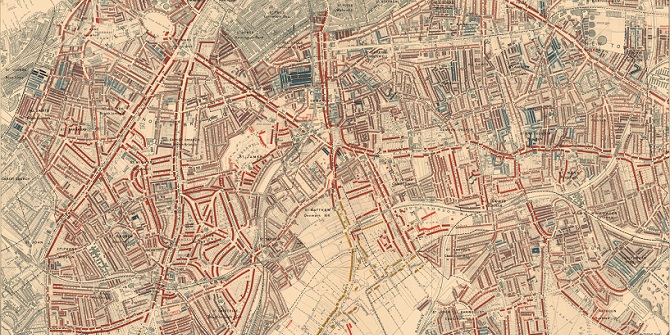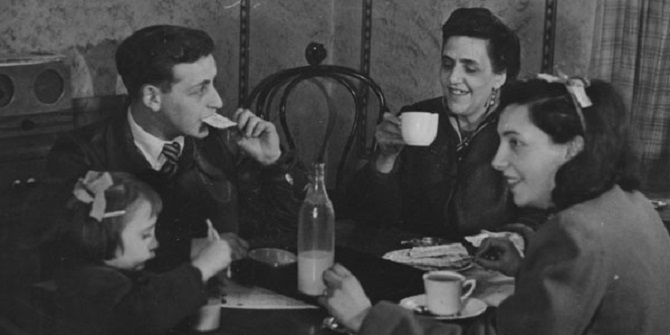In 2011, former head judge of Strictly Come Dancing Len Goodman visited LSE Library as part of an appearance on the family history television programme Who Do You Think You Are. Here he met with LSE archivist Sue Donnelly to learn about living conditions in Bethnal Green in the 19th century using the Charles Booth Poverty Map.
To find out what life was like for his great great grandfather, widower James Eldridge, and his 11 children in Bethnal Green, Len heads to LSE Library to meet archivist Sue Donnelly. and see the Charles Booth’s Poverty Map, an archive that records living conditions in London in the late 19th century.

Sue explains that Charles Booth was a 19th century businessman who was very interested in why there was so much poverty in London, effectively the richest city in the world. So he went out and collected lots of information about rents, wages, sizes of families. He then created colour coded maps showing the levels of poverty and wealth, what he termed social condition, for each street. Sue shows Len a Charles Booth map of Bethnal Green in the late 19th century. At the time that James Eldridge lived in Bethnal Green, it was the poorest area with the densest population, both in terms of the number of people within houses and the number of houses.

Bethnal Green had been rural, but the expansion of London in the 18th century led to increased housing and industry in the area. Many houses were demolished to make way for the arrival of the railway in the 1840s, resulting in overcrowding.
On the Charles Booth map of Bethnal Green, Camden Street, where James Eldridge lived, was colour coded blue meaning it was one of the poorest areas. Sue explains that Booth described this area and street as an area of “chronic want”. “That sums it all up, doesn’t it,” says Len. “Not only are we in the poorest area in London, we’re in one of the most run-down and poorest streets.”

Sue shares some photographs of the area from the same period, one of a row of tightly packed terraced houses. Len comments, “When you think of my great great grandfather James with 11 children and they’re stuck in one of these tiny little houses, it’s just amazing that anyone survived.” “Life expectancy as very low,” replies Sue, “particularly for children and older people.”

Sue shares a copy of The Eastern Argus and Borough of Hackney Times from 14 September 1889. It reports the suicide of James Eldridge. Len reads aloud: “On Sunday morning police constable Gerrard proceeded to 2 Camden Street where he found a man hanging by the neck from the lintel of the door of the WC … the body was identified as that of James Eldridge, 69, a widower who had been well-known in the parish where formerly he carried on business as a builder. Competition and business reverses however appears to have reduced him to such a low ebb that it is alleged he was shortly to have become an inmate in the Bethnal Green workhouse … and the fear of this step is thought to have been the reason for his sacrificing his own life. The jury ultimately returned a verdict of suicide by hanging while in a state of temporary insanity.” Sue points out that by 1889, James’s children would have been married and struggling to look after their own families. He would have had no pension and no support and he didn’t want to go into the workhouse, which is his only other option.

“My overriding feeling is one of sadness,” concludes Len. “Bethnal Green was the poorest area of London. There was no quality of life. They were just struggling day in, day out to put food on the table to feed their families. And to realise that James Eldridge would prefer to commit suicide than go into a workhouse makes me wonder how bad these workhouses were.” Len continues the episode by finding out more about workhouses, to understand James Eldridge’s fear of entering one.
More about Charles Booth’s Poverty Map
Clips from this episode are available to watch on YouTube, with an overview on the Who Do You Think You Are webpages





